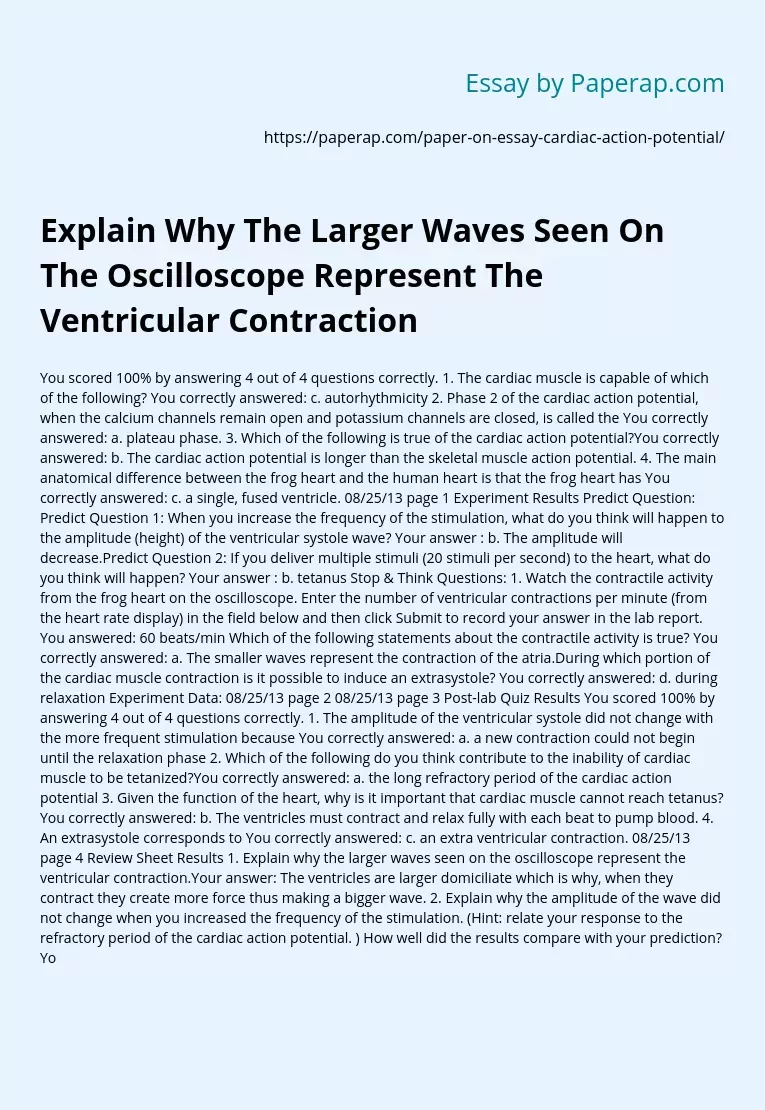Larger waves show ventricular contraction
You scored 100% by answering 4 out of 4 questions correctly. 1. The cardiac muscle is capable of which of the following? You correctly answered: c.
autorhythmicity 2. Phase 2 of the cardiac action potential, when the calcium channels remain open and potassium channels are closed, is called the You correctly answered: a. plateau phase. 3. Which of the following is true of the cardiac action potential?You correctly answered: b. The cardiac action potential is longer than the skeletal muscle action potential. 4. The main anatomical difference between the frog heart and the human heart is that the frog heart has You correctly answered: c. a single, fused ventricle. 08/25/13 page 1 Experiment Results Predict Question: Predict Question 1: When you increase the frequency of the stimulation, what do you think will happen to the amplitude (height) of the ventricular systole wave? Your answer : b.
The amplitude will decrease.Predict Question 2: If you deliver multiple stimuli (20 stimuli per second) to the heart, what do you think will happen? Your answer : b. tetanus Stop & Think Questions: 1. Watch the contractile activity from the frog heart on the oscilloscope. Enter the number of ventricular contractions per minute (from the heart rate display) in the field below and then click Submit to record your answer in the lab report. You answered: 60 beats/min Which of the following statements about the contractile activity is true? You correctly answered: a. The smaller waves represent the contraction of the atria.During which portion of the cardiac muscle contraction is it possible to induce an extrasystole? You correctly answered: d.
during relaxation Experiment Data: 08/25/13 page 2 08/25/13 page 3 Post-lab Quiz Results You scored 100% by answering 4 out of 4 questions correctly. 1. The amplitude of the ventricular systole did not change with the more frequent stimulation because You correctly answered: a. a new contraction could not begin until the relaxation phase 2. Which of the following do you think contribute to the inability of cardiac muscle to be tetanized?You correctly answered: a. the long refractory period of the cardiac action potential 3. Given the function of the heart, why is it important that cardiac muscle cannot reach tetanus? You correctly answered: b. The ventricles must contract and relax fully with each beat to pump blood. 4. An extrasystole corresponds to You correctly answered: c. an extra ventricular contraction. 08/25/13 page 4 Review Sheet Results 1. Explain why the larger waves seen on the oscilloscope represent the ventricular contraction.Your answer: The ventricles are larger domiciliate which is why, when they contract they create more force thus making a bigger wave. 2. Explain why the amplitude of the wave did not change when you increased the frequency of the stimulation. (Hint: relate your response to the refractory period of the cardiac action potential. ) How well did the results compare with your prediction? Your answer: The maximum threshold will not change in cardiac muscle cells (as with any other cells), which is determined by the X amount of voltage needed for calcium channels to open.After this point, no additional voltage can cause the channels to open more, or again, prior to depolarization. 3. Why is it only possible to induce an extrasystole during relaxation? Your answer: cardiac is able to depolarize only after repolarization. 4. Explain why wave summation and tetanus are not possible in cardiac muscle tissue. How well did the results compare with your prediction? Your answer: Cardiac cells have long action potentials and long twitches, therefore do not show temporal summation. 08/25/13 page 5
Essay Example on Explain Why The Larger Waves Seen On The Oscilloscope Represent The Ventricular Contraction
Larger waves show ventricular contraction. (2019, Nov 27). Retrieved from https://paperap.com/paper-on-essay-cardiac-action-potential/

